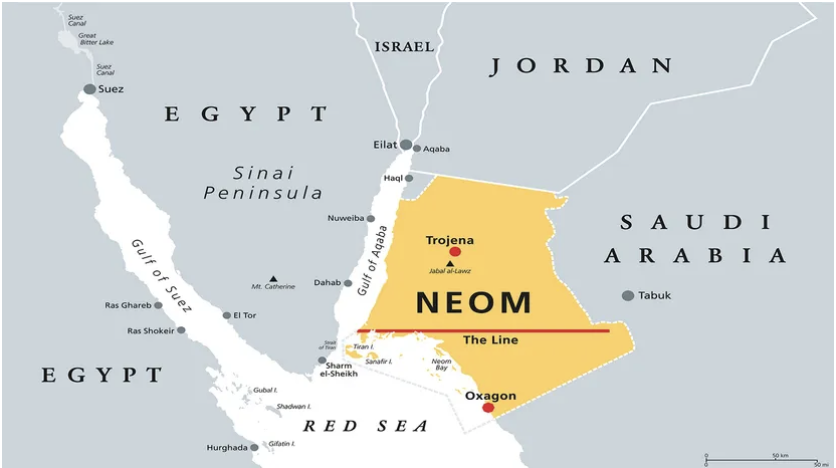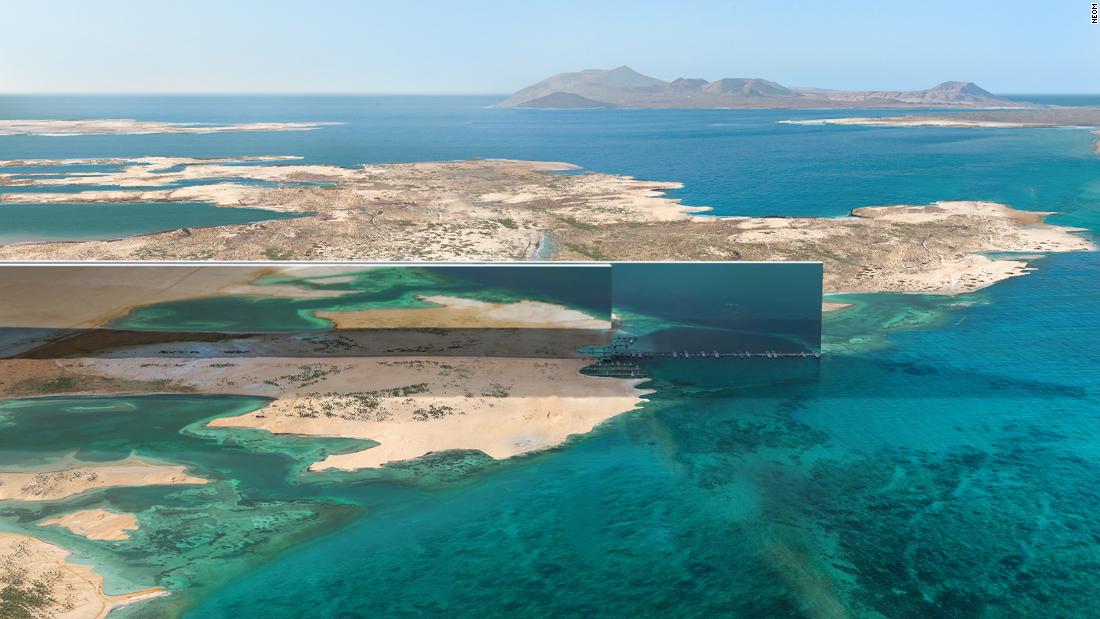The 2021 “Largest Survey of Public Opinion on Climate Change” carried out by the United Nations Development Program found that a majority of people across every age group, nationality, economic standing, and education level classify climate change as an emergency. Consequently, people everywhere are turning to their leaders—whether that be governments or the corporations that run them—for comprehensive climate change policy and drastic changes in the face of what is now commonly called runaway climate chaos.
Saudi Arabia recently answered this call with an interesting proposition: The Line.
The Line is a progressive city-planning venture that will house millions of residents within the larger territory of NEOM. NEOM itself will be a 16,466 square mile area covering the northwest of Saudi Arabia, with The Line as the hub of civilization where all people will reside in order to achieve the project’s goal of having 95% of its land unoccupied, protected wildlands.
The Line aims to be fully sustainable, with zero-emission high-speed transit, no cars, buses, or streets, 100% renewable energy, ample green space, a completely digitized design, and evenly distributed food and amenity outlets. Along with that, The Line will combat urban sprawl with its thin, vertical landscape at 656 feet wide by 1640 feet tall. It has been allotted a massive $725 billion budget, and will eventually become a thriving, 9-million-resident city center. The proposed utopia will span across north-western Saudi Arabia for 105 miles, through diverse natural landscapes from the desert to the Red Sea.

If the proposal proceeds as planned, the prospects are thrilling. After all, drastically changing the norm in how cities are built and operate to reduce greenhouse gas emissions is vital to mitigating and adapting to the effects of the ticking clock of climate change. This is certainly drastic action on Saudi Arabia’s part, and its success would be a hallmark of the future of sustainable city planning. At the same time, it is necessary to question what this kind of undertaking truly represents, and what is being left behind in its shadow, both in Saudi Arabia and the world.
NEOM and The Line were proposed by the Crown Prince of Saudi Arabia, Mohammed bin Salman, as a part of Saudi Vision 2030. He touted of his proposal: “NEOM will be a place for all people from across the globe to make their mark on the world in creative and innovative ways. NEOM remains one of the most important projects of Saudi Vision 2030, and our commitment to delivering The Line on behalf of the nation remains resolute.” The Crown Prince also promised that NEOM would be “a civilizational revolution that puts humans first.”
Yet, Saudi Arabia has not been a model for human rights or environmental progress in the past, and it remains questionable under bin Salman’s reign. As Crown Prince since 2017, Mohammed bin Salman is the “de facto ruler of the kingdom,” though he was also recently appointed as Prime Minister to continue the “slow but steady transfer of power” from the aging King Salman. Mohammed bin Salman also served as Saudi Arabia’s defense minister from 2015 to 2017 until he became the Crown Prince.
Notably, one of bin Salman’s first strategic moves as defense minister was organizing “Operation Decisive Storm” in 2015 against the Iranian-backed Houthi Rebels in Yemen as an aggressive move to weaken Iranian influence. According to Human Rights Watch, the results of this move were thousands of civilian deaths over the course of 4 years due to repeated Saudi airstrikes—an indefinite worsening of Yemen’s humanitarian crisis as the conflict rages on.
The Human Rights Watch also details the international criticism Saudi Arabia faced in 2018 for Mohammed bin Salman’s alleged involvement, and lack of accountability for, the high-profile murder of a Saudi journalist, which came amidst a slew of mistreatment allegations from Saudi human rights activists and journalists.
Al Jazeera’s article on bin Salman’s PM appointment summarizes his questionable record, despite major reforms:
Prince Mohammed has changed Saudi Arabia radically since he rose to power, leading efforts to diversify the economy from dependence on oil, allowing women to drive and curbing the clerics’ power over society. His reforms, however, have come with a massive crackdown on dissent, with activists, royals, women’s rights activists, and businessmen jailed… the measures targeted many of his direct rivals, thus consolidating the prince’s power over the kingdom.
In terms of environmental progressive policy, Saudi Arabia’s experience is relatively new as the world’s largest exporter of oil and one of the largest consumers of oil. But, as global governments finally become more aware of the inevitability of transitioning to renewable energies in place of fossil fuels like oil, in the last five years Saudi Arabia has put forth goals that are far-reaching and comprehensive—other than The Line. They are investing in renewables and have made the impressive goal to have 50% renewable energy by 2030 as a part of Saudi Vision 2030, but it is unclear if The Line’s nine million residents living on 100% renewable energy is added to that statistic.

While the Prince’s reforms in women’s rights and in environmental policy goals are radical within the context of Saudi Arabia’s history with Shari’ah Law and given their economy’s dependency on oil, The Line’s utopian goals seem difficult to reconcile with the slow speed at which Saudi Arabia’s views on women’s rights and other human right’s issues are changing. Can a place like The Line in NEOM be truly successful when major hierarchies remain unchallenged?
What does “a civilization that puts humans first” look like to the Crown Prince given the state of the civilization he already has power over? What is the benefit of asking millions of people with pre-existing ties to their communities, their land, and their ways of life to pick up and start over inside The Line as a way to bolster renewables rather than investing in the cities that they already live in? This is not to say that The Line will be the only place with renewable energy by 2030 as the country’s investment in renewable energy continues over the next decade. But, to dedicate $725 billion to a project that could very well mean hundreds of cities bordering the gold standard of NEOM—if it succeeds as planned—are left behind. The Line is also not an investment in the Saudi people if it is highly likely the majority of people who end up living within The Line will be wealthy foreigners who want to be a part of the Grand Experiment.
The questions surrounding the feasibility and impact of The Line are not to say “what’s the point?” That is a way of thinking that has interfered with so much necessary change throughout our history across all sectors. Rather, they examine the broken structures upon which we are trying to build perfect solutions. We may find that those perfect solutions are very fragile if we pour all of our resources into making new things that are bigger and better instead of addressing how we can make what we have now better for the people who already exist where and as they are. The ultimate question of The Line is: Should we create a new utopia, or should we instead work toward making the rest of the world less of a dystopia?
Featured Image Source: CNN






Comments are closed.